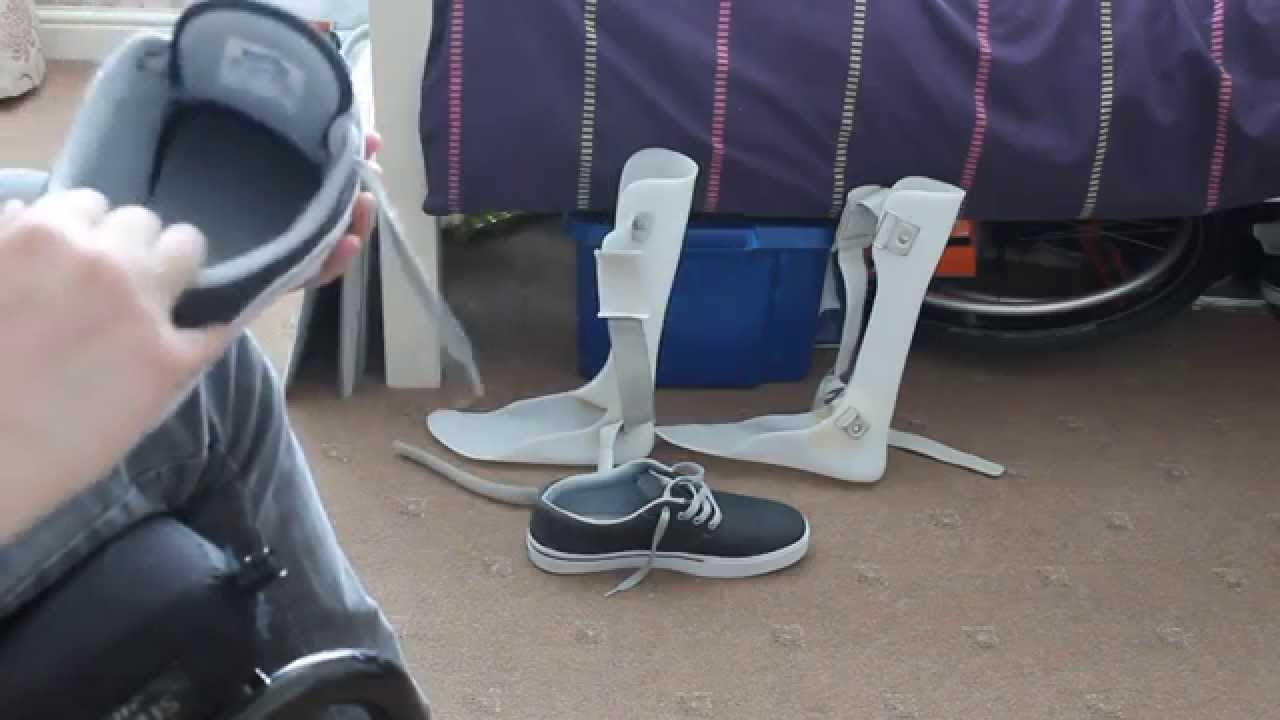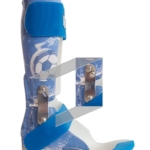Ankle-foot orthoses improve CP gait
Strategies alter ankle, knee kinematics.
Floor-reaction ankle foot orthoses and wedge-based tuning significantly improve ankle and knee kinematics in children with cerebral palsy, according to separate studies from Greenvile, SC, and from Scotland.

Robert Brown Youtube
In the Moment: O&P, Lower Extremity Review November 2009
| Strategies alter ankle, knee kinematics |
Researchers from the Shriners Hospital for Children in Greenville used quantitative gait analysis to study 27 children with cerebral palsy while walking barefoot and with a floor-reaction AFO. Floor reaction AFOs are designed to reduce ankle dorsiflexion and knee flexion by limiting the ability of the tibia to advance over the foot during midstance, which is believed to reduce the internal knee extensor moment associated with crouch gait in CP.
The investigators found that the braced condition was associated with a significant decrease in mean sagittal plane dynamic range of motion at the ankle during stance (from 23º to 10º) and mean peak knee extension in midstance (from 29º to 18º of flexion ). The mean minimum sagittal knee moment in midstance also improved from an internal knee extensor moment to an internal knee flexor moment, although the change was not statistically significant. There was a strong positive correlation between mean minimum sagittal knee moment in midstance and the amount of peak knee extension at the same phase of gait.

Cascade DAFO
The device was found to be most effective in children with knee and/or hip flexion contractures of 10º or less. Hip flexion contractures and knee flexion contractures each had a strong negative correlation with the amount of peak knee extension in midstance. However, neither thigh-foot angle nor mean foot progression angle during stance demonstrated a correlation with peak knee extension, suggesting that knee and hip flexion contractures are better predictors of device efficacy.
The findings, published in the October issue of the Journal of Bone and Joint Surgery (American), are consistent with those of an earlier Brazilian study of 71 children with cerebral palsy and spastic diplegia. In the earlier study, researchers from the Central University of Sao Camilo in Sao Paulo found that wearing a floor-reaction AFO significantly improved abnormal ankle dorsiflexion and knee flexion motion during stance phase.
However, the Brazilian researchers found that the effects of the device were significant only in patients with moderate or severe crouch gait. Kinematics did not change significantly in children with milder limitations (maximum knee extension of less than 15º). Patients with contractures greater than 10º were excluded from the study. The results were published in the February 2007 issue of the Brazilian journal Clinics.
Researchers from Queen Margaret University in Edinburgh, Scotland, are taking a different approach to orthotic management of children with CP. They theorize that a footwear-AFO combination can be optimized, or “tuned,” by adding heel wedges and/or rockers to realign the ground reaction force vector relative to the center of the joint. This realignment, in turn, is thought to reduce abnormal joint moments.
The investigators tested this strategy in five children with cerebral palsy, using wedges for tuning. Three dimensional gait analysis confirmed that the shank-to-vertical angle was closer to normal after tuning, and that knee hyperextension during stance was significantly decreased. No other gait parameters were associated with statistically significant changes, but because of wide inter-subject variability, the authors believe the sample size was not large enough to detect significance. The findings were published in the November 2009 issue of Disability and Rehabilitation – Assistive Technology.
Previously, the same authors presented their results using a similar tuning method in a 61-year-old female patient with left-sided hemiplegia. When her AFO-footwear combination was tuned with wedging and a rocker, knee flexion during early stance increased and hyperextension during midstance decreased along with pain and swelling. That case was presented in June 2007 at the annual meeting of the World Confederation for Physical Therapy.
| Benefits of valgus knee brace wear extend to running as well as walking |
Athletic-minded individuals with osteoarthritis can benefit from wearing a valgus knee brace during running as well as during walking, according to research from the German Sport University in Cologne.
In 16 healthy male subjects with varus alignment, researchers analyzed the effect of a valgus knee brace in three different positions: neutral, 4º and 8º of valgus angulation.
The brace was associated with significant decreases in knee adduction angular impulse and knee adduction moment during both walking and running. Reducing the knee adduction moment is thought to redistribute joint loading and delay osteoarthritis progression.
At 4º, knee adduction angular impulse was decreased by 25% while walking and 18% while running. At 8º, angular impulse was reduced by 36% while walking and 23% while running.
Decreases in first and second peak knee adduction moment were seen during walking at both angulations, ranging from 5% to 33%. However, during running the only significant change in adduction moment was seen when comparing the 8º condition to the no-brace condition, a decrease of 11%.
The results were e-published on September 14 in Clinical Biomechanics.
| Functional bracing after Achilles tear matches surgery for strength recovery |
Recovery of calf muscle strength after acute Achilles tendon rupture is not significantly different when treated nonoperatively with functional bracing or treated surgically, according to research from the Netherlands.
Investigators from Utrecht Hospital performed isokinetic strength testing in 31 surgically treated patients and 25 conservatively treated patients, after three months and at least six months of follow up. After eight to 10 months, similar plantar flexion strength deficits were observed in both groups. The only significant difference between groups was seen for plantar flexion strength at 90º/sec at the long-term follow-up measurement, when conservatively treated patients were significantly stronger. The findings were published in the October issue of Foot & Ankle Specialist.
The strength study involved a subset of patients from an 83-subject randomized controlled trial, the first results of which were published in the September 2008 issue of the American Journal of Sports Medicine. That paper found that time to return to work differed significantly between groups but that complication rates, return to sports, pain and patient satisfaction at one year did not.
Source Lower Extremity Review
| References |
The efficacy of the floor-reaction ankle-foot orthosis in children with cerebral palsy, Rogozinski BM, Davids JR, Davis RB 3rd, Jameson GG, Blackhurst DW. J Bone Joint Surg Am. 2009 Oct;91(10):2440-7. doi: 10.2106/JBJS.H.00965.
Changes in joint kinematics in children with cerebral palsy while walking with and without a floor reaction ankle-foot orthosis, Lucareli PR, Lima Mde O, Lucarelli JG, Lima FP. Clinics (Sao Paulo). 2007 Feb;62(1):63-8. Full text
Effects of tuning of ankle foot orthoses-footwear combination using wedges on stance phase knee hyperextension in children with cerebral palsy – preliminary results, Jagadamma KC, Coutts FJ, Mercer TH, Herman J, Yirrel J, Forbes L, Van Der Linden ML. Disabil Rehabil Assist Technol. 2009 Nov;4(6):406-13. doi: 10.3109/17483100903104774.
Effect of the tuning of ankle foot orthoses-footwear combination (afo-fc) on gait of a hemiplegic patient- a case study, Jagadamma K, Coutts F, Owen E, Herman J, Yirrell J, van der Linden M. Abstract Number: 2662. Physiotherapy 2007;93(S1):S362. 15th International Congress of The World Confederation for Physical Therapy, June 2007, Vancouver, Canada
Effects of foot orthoses and valgus bracing on the knee adduction moment and medial joint load during gait, Shelburne KB, Torry MR, Steadman JR, Pandy MG. Clin Biomech (Bristol, Avon). 2008 Jul;23(6):814-21. doi: 10.1016/j.clinbiomech.2008.02.005. Epub 2008 Mar 24.
A randomized trial of patellofemoral bracing for treatment of patellofemoral osteoarthritis, Hunter DJ, Harvey W, Gross KD, Felson D, McCree P, Li L, Hirko K, Zhang B, Bennell K. Osteoarthritis Cartilage. 2011 Jul;19(7):792-800. doi: 10.1016/j.joca.2010.12.010. Epub 2011 Jan 11. Full text
Recovery of calf muscle strength following acute achilles tendon rupture treatment: a comparison between minimally invasive surgery and conservative treatment, Metz R, van der Heijden GJ, Verleisdonk EJ, Tamminga R, van der Werken C. Foot Ankle Spec. 2009 Oct;2(5):219-26. doi: 10.1177/1938640009348338. Epub 2009 Sep 4.
Acute Achilles tendon rupture: minimally invasive surgery versus nonoperative treatment with immediate full weightbearing–a randomized controlled trial, Metz R, Verleisdonk EJ, van der Heijden GJ, Clevers GJ, Hammacher ER, Verhofstad MH, van der Werken C. Am J Sports Med. 2008 Sep;36(9):1688-94. doi: 10.1177/0363546508319312. Epub 2008 Jul 21.
| Further reading |
Testing Gait with Ankle-Foot Orthoses in Children with Cerebral Palsy by Using Functional Mixed-Effects Analysis of Variance, Zhang B, Twycross-Lewis R, Großmann H, Morrissey D. Sci Rep. 2017 Sep 11;7(1):11081. doi: 10.1038/s41598-017-11282-1. Full text
Unloader braces for medial compartment knee osteoarthritis: implications on mediating progression, Ramsey DK, Russell ME. Sports Health. 2009 Sep;1(5):416-26.
Optimising Ankle Foot Orthoses for children with cerebral palsy walking with excessive knee flexion to improve their mobility and participation; protocol of the AFO-CP study, Kerkum YL, Harlaar J, Buizer AI, van den Noort JC, Becher JG, Brehm MA. BMC Pediatr. 2013 Feb 1;13:17. doi: 10.1186/1471-2431-13-17.
The effects of tuning an Ankle-Foot Orthosis Footwear Combination on kinematics and kinetics of the knee joint of an adult with hemiplegia, Jagadamma KC, Owen E, Coutts FJ, Herman J, Yirrell J, Mercer TH, Van Der Linden ML. Prosthet Orthot Int. 2010 Sep;34(3):270-6. doi: 10.3109/03093646.2010.503225.
Effects of tuning of ankle foot orthoses-footwear combination using wedges on stance phase knee hyperextension in children with cerebral palsy – preliminary results, Jagadamma KC, Coutts FJ, Mercer TH, Herman J, Yirrel J, Forbes L, Van Der Linden ML. Disabil Rehabil Assist Technol. 2009 Nov;4(6):406-13. doi: 10.3109/17483100903104774.
Simulated impacts of ankle foot orthoses on muscle demand and recruitment in typically-developing children and children with cerebral palsy and crouch gait, Rosenberg M, Steele KM. PLoS One. 2017 Jul 13;12(7):e0180219. doi: 10.1371/journal.pone.0180219. eCollection 2017.
Precision orthotics: optimising ankle foot orthoses to improve gait in patients with neuromuscular diseases; protocol of the PROOF-AFO study, a prospective intervention study, Niels F J Waterval, Frans Nollet, Jaap Harlaar, and Merel-Anne Brehm. BMJ Open. 2017; 7(2): e013342. Published online 2017 Feb 28. doi: 10.1136/bmjopen-2016-013342
How can push-off be preserved during use of an ankle foot orthosis in children with hemiplegia? A prospective controlled study, Desloovere K, Molenaers G, Van Gestel L, Huenaerts C, Van Campenhout A, Callewaert B, Van de Walle P, Seyler J. Gait Posture. 2006 Oct;24(2):142-51. Epub 2006 Aug 24.
The effects of tuning an ankle-foot orthosis footwear combination on kinematics and kinetics of the knee joint of an adult with hemiplegia, Jagadamma KC, Owen E, Coutts FJ, Herman J, Yirrell J, Mercer TH, Van Der Linden ML. Prosthet Orthot Int. 2010 Sep;34(3):270-6. doi: 10.3109/03093646.2010.503225.






